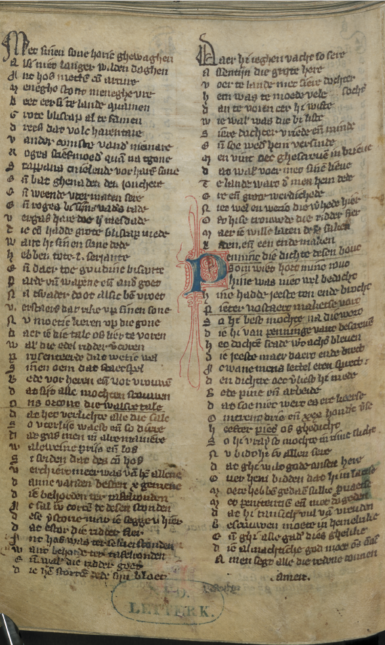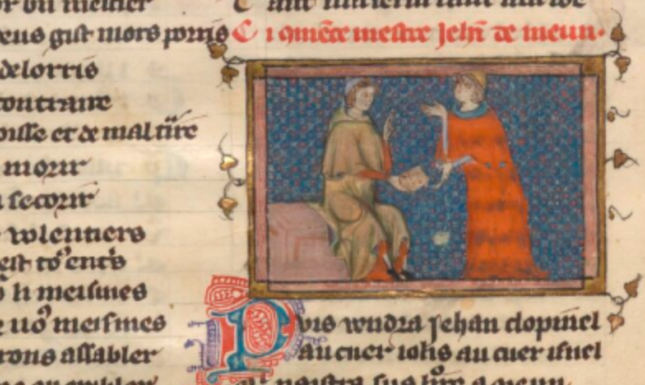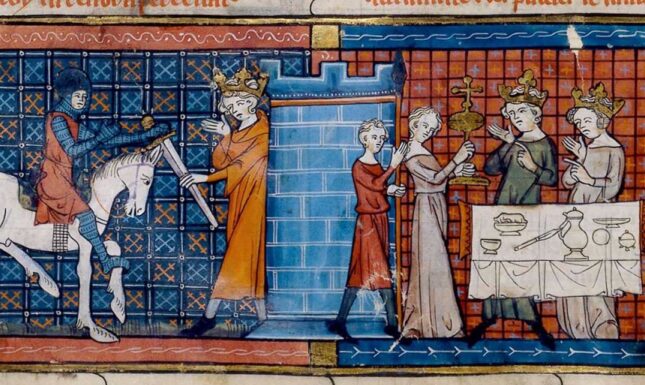To be continued. Medieval and modern motivations for literary continuation
Series, sequels and spin-offs are at the centre of the modern media landscape. But our literary culture has a rich history of continuation and narrative transformation, in particular when it concerns the medieval romance tradition.
During the late 13th-early 14th century, a Dutch translation was produced of the Old French chanson de geste cycle Ogier de Danemarche, which consisted of Enfances d’Ogier and Chevalerie d’Ogier. This translation is currently known only through a 15th century German retelling, the Ogier von Dänemark, which surprisingly contains not one but two prologues, one for each part of the cycle (Besamusca 2005). In this second prologue we get an extraordinary glance into the contemporary origination context of the work (ll. 4178-4234). The narrator tells us that one day he was telling the story of Ogiers Kintheit (i.e., Enfances d’Ogier) to a group of noble women in Flanders, who when he had finished his tale requested him to tell more stories about Ogier. Since the only other story he knew (i.e., Chevalerie d’Ogier) had not yet been translated into Dutch, the ladies asked him to make this translation, which he gladly did.
This situation, fictional as it may perhaps be, shows us how already during the Middle Ages there existed a desire to continue popular stories. But what exactly drives this fascination with literary continuation, and are the motivations of modern and medieval literary actors timebound or rather timeless? To explore this question, we can turn to the narrators like that of Ogier and how they themselves inform us of their motivations for continuing stories through prologues, epilogues and narratorial commentaries. What do these medieval voices tell us (and how ‘medieval’ are they from our modern viewpoint)?
Back by popular demand
In the example of the Flemish noblewomen mentioned in the Ogier, their request is not just for more storytelling, but specifically for more stories about the hero Ogier. Much like modern fans of superheroes like Superman or Batman, the catalyst for more storytelling is often a desire for narrative extension of popular characters who have proven themselves to captivate audiences. One such medieval hero is the Arthurian knight Gauvain, who as a mainstay of the Arthurian court is ever-present in most narratives yet only during the 13th century became a sole protagonist with his own stories. Exemplary of the demand for ‘Gauvain-stories’ is the prologue to the French romance Chevalier á l’Épée, whose narrator condemns the famous Chrétien de Troyes for neglecting this most wonderful hero (ll. 18-25):
L’en en doit Crestiën de Troies Ce m’est vis, par raison blasmer, Qui sot dou roi Artu conter, De sa cort et de sa mesniee Qui tant fu loee et prisiee Et qui les fex des autres conte Et onques de lui ne tint conte. Trop ert preudon a obliër.
In my opinion it is right to criticize Chrétien de Troyes, who knew how to tell stories about King Arthur, his court and his company of knights who were so highly praised and esteemed, and who told the deeds of others but who never told a story about him [Gauvain]. He was too worthy a man to be forgotten.
A similar stance is found in the Moriaen, a 13th century Dutch romance that is inserted in the Lancelot compilation, a ten-part narrative cycle based on the Old French Lancelot-Graal-Mort Artu trilogy. In the prologue of this text, the author expresses his dismay that amidst telling the story of Lancelot one could forget the ‘scone bediet’ of Moriaen (ll. 23-29):
Ic wane die gene di Lancelote maecte Dat hem in sijn dichten vaecte Dat hi vergat ende achter liet Van Moriane dat scone bediet. Mi wondert wies si hen onderwinden Die dichten wilt ende rimen vinden Sine volbrachten daer af die tale.
I think that whoever made the Lancelot Must have neglected his writing For he forgot and left out The beautiful story of Moriaen. I wonder why people decide to Start writing and rhyming When they do not finish their story.

No finish, no value
As the final lines of Moriaen’s citation illustrate, the demand for literary continuation became all the more pressing when a work was considered to be incomplete. Illustrative is the epilogue of the 13th century Roman van Walewein, which was started by Penninc but later completed by Pieter Vostaert, who emphasizes the lack of value attributed to unfinished works (ll. 11173-11185):
Penninc, die dichte desen bouc – So wiet hort, mine rouc – Hine was niet wel bedocht Hine hadde [die] jeeste ten ende brocht. Pieter Vostaert maketse vort So hi best mochte na die wort Die hi van Penninge vant bescreven: Het dochtem scade, waert achter bleven Die jeeste, maer daert ende brect Ic wane mens lettel eren sprect Den dichtre; oec verliest hi mede Bede pine ende arbeide Dat soe niet wert es ere keerse.
Penninc, who composed this book – I do not care who hears it – Was unwise not To have brought it to an end. Pieter Vostaert continued it As best he could according to the text That he found which Penninc left behind: It seemed to him a pity for it To be left unfinished, but seeing as how it lacked A conclusion, I believe little credit would have been Accorded the poet; what is more without an ending All of his pains and effort would Not have been worth a cherry.
Conversely, those works that did get completed often ended up becoming European canonical best sellers, such as the Roman de la Rose, the Canterbury Tales, Gottfried von Straßburg’s Tristan and Chrétien de Troyes’ Conte du Graal.
This latter work is especially interesting as it spawned not one but four separate continuations and, as some scholars have argued, appears to invite continuation as much as its continuators tend to postpone completion. Emblematic for this stance is the quest for a broken sword that only the best Christian knight can fix: it is absent in the unfinished Conte du Graal, introduced in the First Continuation, restored in the Second Continuation bar one tiny crack, and finally completed in the Gerbert Continuation.
Importantly, this example highlights that for medieval writers the act of continuation could also be employed as a literary vessel for creativity or narrative redirection – much like how modern storytellers take creative liberaties when retelling or republishing stories (see for instance the recent real-life remake of Disney’s Little Mermaid, which transported the story from a Mediterranean setting to a Caribbean one).

Literary advertisement
As a concluding example, an interesting instance of narratorial commentary is found in Book III of the 14th century Roman van Limborch. Along the various journeys and adventures of this twelve-part epic series, the knight Heinric impregnates princess Europa, who gives birth to their son Olivier. Whereas Olivier does not play any part in the remainder of the Limborch, the narrator does hint at future stories about him that the audience might be interested in (Book III, ll. 803-807):
Die weten wille sine aventure, Beide dat zoete ende dat zure, Ende hoe hi ierst quam te hove, Hi ga met minnen orlove Ten boecke dat van hem es algader.
Who wants to know about his adventures, Both the good and the bad, And how he first came to the [Spanish] court, He will delight me to go Read the book that tells about him.
Here the desire for more stories comes not from an audience member or patron, but out of anticipation by the narrator-author himself. Yet what makes this call for a sequel or spinoff even more fascinating is the phrasing ‘met minnen orlove’, which could be understood along the lines of ‘with my permission’, but also, as is done above according to the Middelnederlandsche Woordenboek, as a statement referring back to the narrator: he himself is happy with readers of his text venturing off into spinoffs of his story. In this light, is it too far-fetched to wonder if perhaps the book of Oliver might also be among the repertoire of the Limborch poet? If so, this reference adds a commercial element to medieval narrative continuation and seriality that is often considered non-existent for the premodern period.

Conclusion
Drawing from this modest pool of examples, we get a sense of what drove medieval writers to narrative extension and literary continuation and, notably, that their motivations often align with those of modern writers, audiences and publishers. Popular heroes invite further narration, while popular works may provide a solid basis for spinoffs, sequels and seriality. In all cases, writers balance their individual desires to explore new themes and tell new stories with their heartfelt duties to place value onto otherwise incomplete or wanting works and possible commercial interests. By expanding our search to more texts across the European romance tradition, these findings may themselves be expanded and possibly transformed. As such, the research on our fascination with continuation remains to be continued.
Sources:
Roman van Heinric en Margriete van Limborch, gedicht door Heinric, ed. by L.Ph.C. van den Bergh (Leiden 1846-1847).
Moriaen, ed. by Hanneke van Buuren & Maurits Gysseling (Zutphen 1971).
Beate Schmolke-Hasselmann, The Evolution of Arthurian Romance. The Verse Tradition from Chrëtien to Froissart. Trans. by Margaret & Roger Middelton (Cambridge 1998).
Dutch Romances. Vol. I: Roman van Walewein, ed. & trans. by David Johnson & Geert Claassens (Cambridge 2000).
Bart Besamusca, “Zingende minstrelen, een jonge dichter en een voordracht in Vlaanderen. Over de twee prologen van Ogier von Dänmark”, in: Karolus Rex. Studie over de middeleeuwse verhaaltraditie rond Karel de Grote, ed. by Bart Besamusca & Jaap Tigelaar (Hilversum 2005), 141-152.
Further reading:
Leah Tether, The Continuations of Chrétien’s Perceval. Content and Construction, Extension and Ending (Cambridge 2012).
Cycles, Sequels, Spin-offs, Remakes, and Reboots: Multiplicities in Film and Television, ed. by Amanda Klein & Barton Palmer (Austin 2016).
Jelmar Hugen and Geert Warnar, “Pieter Vostaert en het paragraafteken. De Roman van Walewein als onvoltooid verhaal met een zelfstandige voortzetting”, Tijdschrift voor Nederlandse Taal- en Letterkunde 133.3 (2017), 183-203.
Jane Taylor, “Rewriting: Translation, Continuation and Adaptation”, in: Handbook of Arthurian Romance. King Arthur’s Court in Medieval European Literature, ed. by Leah Tether & Brian McFadyen (Berlin 2017), 167-181.


